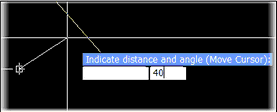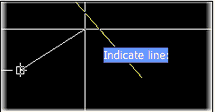Move Cursor
Edit > Move Cursor
Move the current control to a new position.
You can indicate the new position by entering the new coordinates, or by entering the distance and angle of the movement.
- Enter coordinates: Enter the absolute coordinates of the desired new position in the dynamic input field, and press Enter.
- Indicate point: Move the mouse pointer to the desired position, and press Enter.
Length and Angle: Enter a relative distance and angle for the current control movement. After switching to the Length and Angle mode, this option will be replaced by the Coordinates mode for entering absolute coordinates.
Special Features
Using the current control position in coordinate mode
By emptying one of the dynamic input fields you can use the width or height value of the current control.
Example: The current control coordinate is (122, 2500) which means frame number 122 and height of 2500 millimeters. To move the current control from the current position to the height of 2000 millimeters, empty the first field on the dynamic input, enter 2000 in the second field, and press Enter. If you want to move the current control horizontally, enter the width value in the first field, empty the second field.
Fixed angle, line intersection in length and angle mode
To move the current control with a certain angle to an intersect point, empty the distance (first) field of the dynamic input, enter the required angle, press Enter, and point to the intersecting line.
The pictures below show in three stages of how to move the current control with an angle of 40 degrees to the intersection point of another line.
|
Fixed length, line angle in length and angle mode
To move the current control with a certain length, parallel to another line, enter the required line length in the first field of the dynamic input, empty the angle field, press Enter, and point to a line segment.
The position of the indicated point on the existing line segment defines the direction of the movement. The direction of the movement is the same as the direction of the nearest end point to the indicated point.
Copy line direction and angle in length and angle mode
By emptying the distance field and the angle field on the dynamic input, you can use the length and angle of the pointed line segment. The direction of the new line segment is the same as the direction of the nearest end point to the indicated point.


